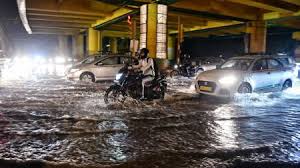More than 12% of Indian data centres at risk from extreme weather events: Study

India’s rapidly expanding digital infrastructure is now facing a silent but serious threat—climate change. A recent study by climate risk analyst XDI (The Cross Dependency Initiative) has found that over 12% of data centres in India are at high risk from extreme weather events such as flooding, heatwaves, and storms by the year 2050. As the country moves to become a global digital hub, this revelation poses questions about how prepared we are to protect the backbone of our internet economy.
The Findings: Climate Risk to India’s Digital Backbone
The study analyzed nearly 9,000 data centres around the world to determine their exposure to physical climate risks. Out of 228 data centres in India, more than one in ten are already at high physical climate risk. That number is expected to increase significantly by mid-century if emissions and global warming trends continue unchecked.
While climate change has long been associated with rising sea levels, erratic weather patterns, and agricultural disruption, this study brings to light a less discussed but equally critical consequence: the vulnerability of digital infrastructure. In India, where cloud services, fintech, e-commerce, and AI-driven platforms are scaling rapidly, the risk to data centres could have cascading effects across multiple sectors.
Cities at Highest Risk: Noida, Chennai, Mumbai, Hyderabad, Bengaluru
The report highlights five major urban clusters as hotspots of climate vulnerability:
1. Noida (Uttar Pradesh)
Noida has emerged as one of the most severely impacted zones globally, ranking second worldwide in terms of high climate risk to data centres. Over 60% of its data centres are already considered high-risk. With rapid urbanisation and limited drainage infrastructure, the city faces severe flood hazards.
2. Chennai (Tamil Nadu)
Being a coastal city, Chennai is no stranger to floods. The study indicates that more than 10% of its data centres are already high-risk, and nearly two-thirds are at moderate risk. Sea-level rise, intense rainfall, and cyclonic storms are major threats.
3. Mumbai (Maharashtra)
Mumbai’s data centres currently face moderate levels of risk, but projections suggest a 133% increase in infrastructure risk by 2100. With a dense population and coastal exposure, any disruption could have national-level consequences.
4. Bengaluru (Karnataka)
Known as the Silicon Valley of India, Bengaluru also appears on the list. While not coastal, the city faces threats from urban flooding, particularly during the monsoon season. Heavy rains have already impacted tech parks in the recent past.
5. Hyderabad (Telangana)
Hyderabad, another emerging data centre hub, is also vulnerable to extreme heat and changing rainfall patterns. While it shows lower flood risks than Mumbai or Chennai, its exposure to rising temperatures could drive up operational costs.
What Are the Risks?
🔌 Outages and Downtime
Power failures due to floods or extreme heat can cause servers to shut down, affecting critical applications ranging from banking systems to emergency services. Data centres require uninterrupted cooling and electricity—both of which are compromised during climate events.
💸 Rising Operational Costs
Cooling systems in data centres are already a major contributor to energy usage. Rising temperatures mean higher cooling requirements, increasing electricity bills and carbon emissions, creating a vicious cycle.
📉 Economic Fallout
Downtime in a major data centre doesn’t just affect the tech industry. It can halt stock trading, disrupt digital payments, affect telecom services, and slow down logistics. In a digitally dependent economy, even minutes of outage can cost millions.
🏗️ Infrastructure Vulnerability
Even if the data centre itself is well-built, if the surrounding infrastructure—roads, power lines, internet cables—is damaged during a storm or flood, the facility becomes inaccessible or non-operational.
Can India Adapt?
The report emphasizes that while the numbers look alarming, there is room for optimism. With strategic investments in resilience and climate adaptation, two-thirds of the high-risk data centres can significantly reduce their vulnerability.
✅ Flood-Proofing & Elevation
Constructing new data centres on elevated land or platforms can reduce exposure to floods. Retrofitting existing structures with better drainage and waterproofing is another immediate step.
✅ Green Cooling Solutions
Innovative cooling systems that use less water and energy—like geothermal cooling or AI-optimized climate control—can reduce dependence on traditional air conditioning, which becomes unreliable during heatwaves.
✅ Risk Assessment Tools
Tech companies must incorporate climate risk data into their site selection and investment decisions. Planning new data hubs in lower-risk regions and away from high-risk floodplains will be key.
✅ Government Policy
State and central governments must introduce building codes that enforce climate resilience, provide incentives for green infrastructure, and regulate the location of future data centres based on long-term risk.
The Global Picture
India is not alone. The study shows that globally, over 6.25% of all data centres are already in high-risk zones, rising to 7.13% by 2050. However, the concentration of risk in Indian cities is notably higher due to a combination of rapid urban development, climate vulnerability, and poor urban planning.
Final Thoughts: A Wake-Up Call for Digital India
India’s ambition to become a global digital powerhouse must now factor in the growing threat of climate change. As we invest in faster internet, AI, and cloud services, we must not forget the physical infrastructure that makes all this possible.
The XDI report is not just a warning—it’s an opportunity. With timely interventions, India can not only safeguard its digital economy but also emerge as a leader in climate-resilient tech infrastructure. Failure to act, however, could mean billions in losses and compromised national security in an increasingly connected world.






